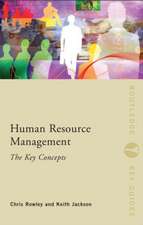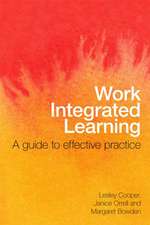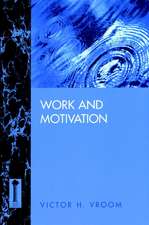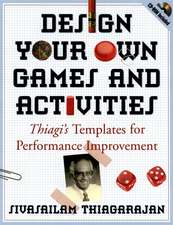Organizational Learning and Development: From an Evidence Base
Autor Paul Kearnsen Limba Engleză Paperback – 24 sep 2014
This new book by Paul Kearns focuses on the need for an evidence-based approach to learning and development, bringing together the author’s extensive knowledge of HRM and organizational learning with new developments in the field. The book demonstrates how evidence evaluation can improve professionalism in organizational design and development, showing that this approach can create value not just for shareholders, but for employees and society as a whole.
Organizational Learning and Development: From an Evidence Base is the perfect book for postgraduate students studying on evidence-based HRM courses and for the reflective learning and development practitioner.
| Toate formatele și edițiile | Preț | Express |
|---|---|---|
| Paperback (1) | 411.42 lei 6-8 săpt. | |
| Taylor & Francis – 24 sep 2014 | 411.42 lei 6-8 săpt. | |
| Hardback (1) | 1000.45 lei 6-8 săpt. | |
| Taylor & Francis – 3 oct 2014 | 1000.45 lei 6-8 săpt. |
Preț: 411.42 lei
Nou
Puncte Express: 617
Preț estimativ în valută:
78.73€ • 84.18$ • 65.64£
78.73€ • 84.18$ • 65.64£
Carte tipărită la comandă
Livrare economică 18 aprilie-02 mai
Preluare comenzi: 021 569.72.76
Specificații
ISBN-13: 9781138022041
ISBN-10: 1138022047
Pagini: 246
Ilustrații: 35 black & white illustrations, 2 black & white tables, 1 black & white halftones, 34 black & white line drawings
Dimensiuni: 156 x 234 x 13 mm
Greutate: 0.34 kg
Ediția:1
Editura: Taylor & Francis
Colecția Routledge
Locul publicării:Oxford, United Kingdom
ISBN-10: 1138022047
Pagini: 246
Ilustrații: 35 black & white illustrations, 2 black & white tables, 1 black & white halftones, 34 black & white line drawings
Dimensiuni: 156 x 234 x 13 mm
Greutate: 0.34 kg
Ediția:1
Editura: Taylor & Francis
Colecția Routledge
Locul publicării:Oxford, United Kingdom
Public țintă
Postgraduate and ProfessionalCuprins
1.Developing mature organizations for societal value 2.The evaluation challenge - theory and practice 3.Making a convincing case for the strategic value of OL&D 4.Learning design 5.Strategic OL&D is integral to business strategy 6.The role of OL&D in a mature organization 7.Designing and developing the whole system
Chapter 1
Developing mature organizations for societal value - Milton Friedman said a company’s only social responsibility is to make a profit - he was wrong - its social responsibility is to create as much societal value as possible from its capital and that includes human capital. What has been holding society back is the failure of the organizational learning and development profession’s inability to put a value on learning and development. All organizations need to embark on a developmental journey along the Organizational Learning Maturity Scale if they are to make the most of their human capital.
Chapter 2
The evaluation challenge - theory and practice -the theory of evaluation is very simple. Start with a measure of where you are - the baseline - and check again afterwards that there has been some improvement. If it is that simple why do OL&D practitioners refuse to see it that way? Evaluation of learning has never been used to full effect in organizations because of ignorance, resistance and conventional accounting methods that only measure the cost of learning, not the benefits.
Chapter 3
Making a convincing case for the value of OL&D - all learning and development can be linked to tangible value - some of it is basic value - the things the organization needs to operate and some of it is added value - improving the organization. The clearest business case comes from adapting conventional ratios, such as ROI to reveal the true value of learning.
Chapter 4
Learning design - sheep dip and scattergun training are completely out-moded methods. If you want to get the best value out of the way your people learn then learning has to be designed with that end in mind. Each human being is a unique individual and will learn best when the method suits them. Coaching and talent management might sound like better approaches but are they? All learning has to be designed to produce clear evidence that it has been effective.
Chapter 5
Strategic OL&D is integral to business strategy - strategic planning frameworks have not been designed to incorporate the competitive advantages of being a learning organization. Ensuring that learning is factored into business plans is a highly skilled job that can only be handled by an OL&D professional. Training budgets and training plans are never going to be strategic unless they are totally integrated.
Chapter 6
The role of OL&D in a mature organization - the role of the OL&D Professional is a brand new role because it is evidence-based. These professionals can only be as effective as the maturity of the people and the organization they work with. Executives and managers have to be educated to raise their own game of staff development and talent management to match the professional requirements of a learning organization.
Chapter 7
Designing and developing the whole system - the most mature organizations are whole systems. Whole systems are the most effective organizations and offer the highest value to shareholders, employees and society as a whole. This is organizational nirvana and it can be achieved by the majority of organizations once they know what is required.
Chapter 1
Developing mature organizations for societal value - Milton Friedman said a company’s only social responsibility is to make a profit - he was wrong - its social responsibility is to create as much societal value as possible from its capital and that includes human capital. What has been holding society back is the failure of the organizational learning and development profession’s inability to put a value on learning and development. All organizations need to embark on a developmental journey along the Organizational Learning Maturity Scale if they are to make the most of their human capital.
Chapter 2
The evaluation challenge - theory and practice -the theory of evaluation is very simple. Start with a measure of where you are - the baseline - and check again afterwards that there has been some improvement. If it is that simple why do OL&D practitioners refuse to see it that way? Evaluation of learning has never been used to full effect in organizations because of ignorance, resistance and conventional accounting methods that only measure the cost of learning, not the benefits.
Chapter 3
Making a convincing case for the value of OL&D - all learning and development can be linked to tangible value - some of it is basic value - the things the organization needs to operate and some of it is added value - improving the organization. The clearest business case comes from adapting conventional ratios, such as ROI to reveal the true value of learning.
Chapter 4
Learning design - sheep dip and scattergun training are completely out-moded methods. If you want to get the best value out of the way your people learn then learning has to be designed with that end in mind. Each human being is a unique individual and will learn best when the method suits them. Coaching and talent management might sound like better approaches but are they? All learning has to be designed to produce clear evidence that it has been effective.
Chapter 5
Strategic OL&D is integral to business strategy - strategic planning frameworks have not been designed to incorporate the competitive advantages of being a learning organization. Ensuring that learning is factored into business plans is a highly skilled job that can only be handled by an OL&D professional. Training budgets and training plans are never going to be strategic unless they are totally integrated.
Chapter 6
The role of OL&D in a mature organization - the role of the OL&D Professional is a brand new role because it is evidence-based. These professionals can only be as effective as the maturity of the people and the organization they work with. Executives and managers have to be educated to raise their own game of staff development and talent management to match the professional requirements of a learning organization.
Chapter 7
Designing and developing the whole system - the most mature organizations are whole systems. Whole systems are the most effective organizations and offer the highest value to shareholders, employees and society as a whole. This is organizational nirvana and it can be achieved by the majority of organizations once they know what is required.
Recenzii
‘Applied learning has for thousands of years been one of the main driving forces of humankind. How come then that the organizational learning & development of today frequently delivers such low value? Can it be changed? Generating business or organizational value through learning & development brings satisfaction and meaning to learners, to their managers and of course, to the organizational learning & development professionals involved. This book is about how to make it happen.’ - Stanislav Tichý, Managing Director of DEVELOR Czech, the L&D partner
‘For organizational development practitioners to gain the most benefit from this book you need to care equally about three things: the people who work in your organization; competitive advantage and how the outputs of your department are measured. Dip into any section and you will find something to provoke, inspire and make you feel uncomfortable – it will challenge you to reflect professionally on how to improve your contribution and add value to the organization, its people and your department.’ - Dr Colleen Harding, Head of Organisational Development, Bournemouth University, UK
‘This book is the best blueprint we have to move learning and development into full-fledged business partners with permanent seats at the table. If we can follow the principles in this book, L&D will no longer have to fight to stay relevant and prove its value. Highly recommend.’- Angela Risner, Chief Happiness Officer/Creative Officer behind Orange Learning Solutions, USA
‘For organizational development practitioners to gain the most benefit from this book you need to care equally about three things: the people who work in your organization; competitive advantage and how the outputs of your department are measured. Dip into any section and you will find something to provoke, inspire and make you feel uncomfortable – it will challenge you to reflect professionally on how to improve your contribution and add value to the organization, its people and your department.’ - Dr Colleen Harding, Head of Organisational Development, Bournemouth University, UK
‘This book is the best blueprint we have to move learning and development into full-fledged business partners with permanent seats at the table. If we can follow the principles in this book, L&D will no longer have to fight to stay relevant and prove its value. Highly recommend.’- Angela Risner, Chief Happiness Officer/Creative Officer behind Orange Learning Solutions, USA
Descriere
It is now widely accepted that organizational maturity is dependent on being able to reorganize on a continuous basis and learn faster and more effectively than your competitors. This new book by Paul Kearns focuses on the need for an evidence-based approach to learning and development, bringing together the author’s extensive knowledge of human resource management with new developments in the field.
Organizational Learning and Development: From An Evidence Base is the perfect book for postgraduate students studying on evidence-based HRM courses and for the reflective learning and development practitioner.
Organizational Learning and Development: From An Evidence Base is the perfect book for postgraduate students studying on evidence-based HRM courses and for the reflective learning and development practitioner.









